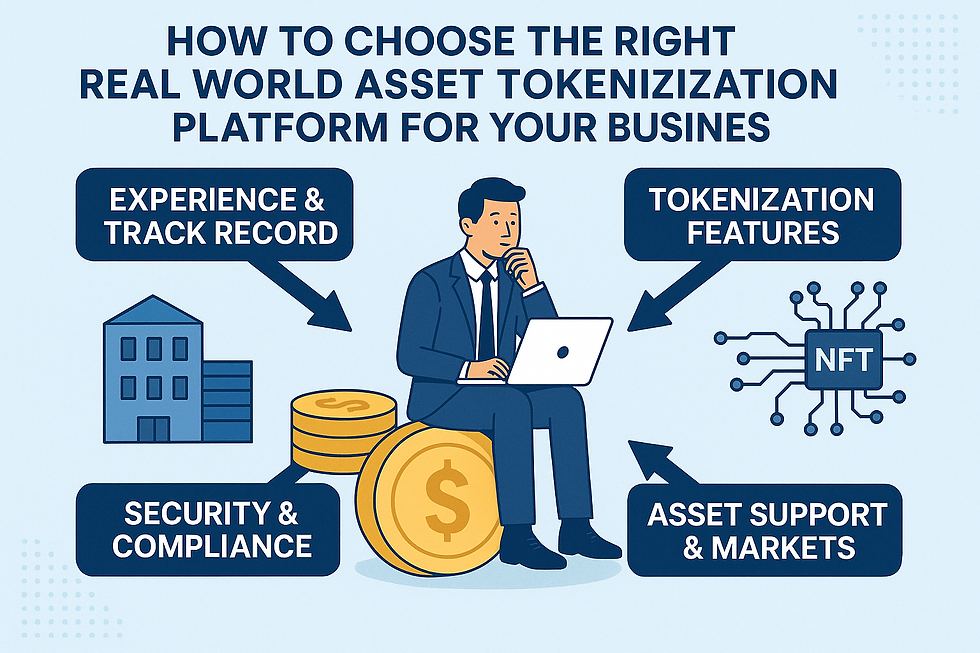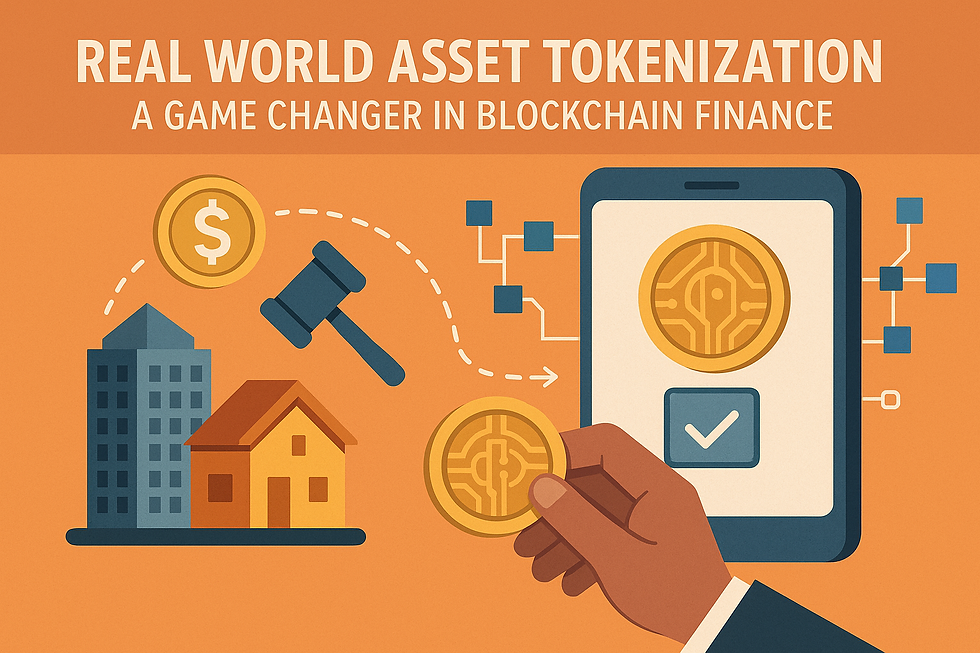Real World Asset Tokenization Ecosystem: Cost & Benefits
- steveganger
- Jun 25
- 5 min read
The Real World Asset Tokenization Ecosystem is redefining how traditional financial systems interact with blockchain technology. As institutions and individuals look for smarter, faster, and more secure ways to handle tangible assets like real estate, commodities, art, and equities, tokenization is emerging as the ideal solution. But while the benefits are substantial, businesses and investors must understand the cost to build Real World Asset Tokenization Platforms and the full economic and operational advantages of this evolving digital ecosystem.
What Is the Real World Asset Tokenization Ecosystem?
The Real World Asset Tokenization Ecosystem refers to the complete infrastructure and set of technologies used to convert real-world assets (RWAs) into digital tokens on a blockchain. This ecosystem includes smart contracts, token issuance platforms, regulatory compliance layers, custodial solutions, identity verification tools, liquidity protocols, and secondary marketplaces.
By integrating physical assets into a blockchain-based framework, the Real World Asset Tokenization Ecosystem makes ownership more transparent, divisible, and tradable globally.
Core Components of the Real World Asset Tokenization Ecosystem
To grasp the cost to build Real World Asset Tokenization Platforms, it’s essential to understand what elements are involved in the Real World Asset Tokenization Ecosystem:
1. Asset Identification & Legal Structuring
Legal wrapping of assets
Jurisdictional compliance
Title verification and ownership validation
2. Smart Contracts
Automated management of token issuance, rights, and settlements
Customizable to reflect equity, profit-sharing, rental income, or other utility structures
3. Token Issuance Platform
Interfaces for creating, managing, and distributing security or utility tokens
Includes wallet integration and investor onboarding
4. Compliance & KYC/AML
Ensures the ecosystem operates within the legal framework
Involves integrating third-party KYC/AML tools or building in-house systems
5. Custodianship & Oracles
Real-world link between physical asset and its digital representation
Secure storage or legal custodianship of physical items
6. Trading Platforms / Secondary Markets
Enable liquidity for tokenized assets
Includes order books, matching engines, and pricing oracles
Cost to Build Real World Asset Tokenization Platforms
Building a full-fledged Real World Asset Tokenization Ecosystem requires a significant investment in technology, compliance, infrastructure, and security.
1. MVP Development Cost
For a basic MVP that allows token creation, basic compliance, and wallet integration, the cost to build Real World Asset Tokenization Platforms ranges between $40,000 to $75,000.
2. Advanced Platform Features
For platforms including:
Automated compliance engine
Multi-asset support
Fiat & crypto payment gateways
Integrated secondary marketThe cost to build Real World Asset Tokenization Platforms can rise up to $150,000 to $300,000 depending on scale, customizations, and regulatory coverage.
3. Enterprise-Grade Tokenization Ecosystem
For financial institutions or global players, the Real World Asset Tokenization Ecosystem must offer:
API integrations with banks or financial tools
High-throughput blockchain infrastructure
Custodial wallet systems
AI-based compliance monitoring
Here, the cost to build Real World Asset Tokenization Platforms may exceed $500,000, often stretching into millions based on scale and compliance needs.
Major Benefits of the Real World Asset Tokenization Ecosystem
Despite the upfront cost to build Real World Asset Tokenization Platforms, the long-term benefits are transformational:
1. Fractional Ownership
Enables investors to own a portion of expensive assets like real estate or artwork
Increases access and lowers entry barriers
2. Improved Liquidity
Tokenized assets can be traded globally 24/7
Eliminates traditional market limitations and improves capital mobility
3. Reduced Transaction Costs
No intermediaries like brokers or banks are required
Smart contracts automate ownership transfers and compliance
4. Transparency & Security
Every transaction is recorded on the blockchain
Reduces the risk of fraud and boosts investor confidence
5. Access to Global Capital
Attracts international investors through borderless token offerings
Expands market exposure for asset holders
Industries Benefiting from Real World Asset Tokenization Ecosystems
The Real World Asset Tokenization Ecosystem is not industry-specific. Its reach spans across:
Real Estate: Tokenizing commercial and residential properties
Precious Metals & Commodities: Digitizing ownership of gold, oil, and other assets
Fine Art & Collectibles: Turning rare items into tradable digital tokens
Private Equity & Venture Capital: Offering fractional shares of startups or funds
Carbon Credits & Energy Assets: Enabling transparency and verifiability
Each industry has unique compliance and cost structures, influencing the total cost to build Real World Asset Tokenization Platforms.
Regulatory Considerations in Asset Tokenization
A crucial element of the Real World Asset Tokenization Ecosystem is staying compliant with local and international regulations. These include:
SEC and FINMA guidelines
MiCA (Markets in Crypto Assets) regulation in Europe
Smart contract auditing and legal token structuring
Integrating compliant frameworks increases the overall cost to build Real World Asset Tokenization Platforms, but failure to do so can lead to heavy penalties or platform shutdowns.
Technical Stack Required for Real World Asset Tokenization Ecosystem
Here’s a basic tech stack you’ll need when considering the cost to build Real World Asset Tokenization Platforms:
Frontend: ReactJS, Next.js
Backend: Node.js, Python, or Go
Smart Contracts: Solidity for Ethereum, Move for Aptos, Rust for Solana
Blockchain Layer: Ethereum, Polygon, Avalanche, or private chains like Hyperledger
Database: PostgreSQL, MongoDB
Security: Multi-signature wallets, encryption, role-based access control
Each selection affects the efficiency, scalability, and ultimately the cost of the Real World Asset Tokenization Ecosystem.
Challenges in Building a Tokenization Ecosystem
Before entering the space, businesses should be prepared for the following challenges:
Complex Legal Frameworks
Interoperability between blockchains
High compliance cost
Market education and adoption
Though these obstacles exist, overcoming them unlocks the full potential of the Real World Asset Tokenization Ecosystem.
The Future of Real World Asset Tokenization Ecosystems
As the global financial ecosystem leans into blockchain, the Real World Asset Tokenization Ecosystem is poised for rapid adoption. According to industry forecasts, tokenized RWAs could surpass $10 trillion in value by 2030.
This massive growth indicates that early adopters who invest in the cost to build Real World Asset Tokenization Platforms today are likely to see major ROI in the years to come.
Final Thoughts
The Real World Asset Tokenization Ecosystem offers an advanced framework for digitalizing real-world value. Although the cost to build Real World Asset Tokenization Platforms varies based on features, scale, and compliance, the benefits — fractional ownership, global liquidity, increased transparency — far outweigh the initial investment.
Businesses, fintech companies, and investors aiming to unlock the next frontier of finance must seriously consider participating in or developing their own Real World Asset Tokenization Ecosystem.
FAQ: Real World Asset Tokenization Ecosystem
Q1: Is the Real World Asset Tokenization Ecosystem safe?
Yes. When developed with robust security protocols and compliant with regulations, it offers enhanced safety over traditional asset systems.
Q2: How long does it take to build a Real World Asset Tokenization Platform?
Depending on complexity, 3 to 9 months is typical for full development.
Q3: What is the most expensive component in the tokenization process?
Compliance and legal structuring typically incur the highest cost in the Real World Asset Tokenization Ecosystem.
Q4: Can startups enter the Real World Asset Tokenization space affordably?
Yes. MVP solutions can be built with a lower budget and scaled over time.






Comments